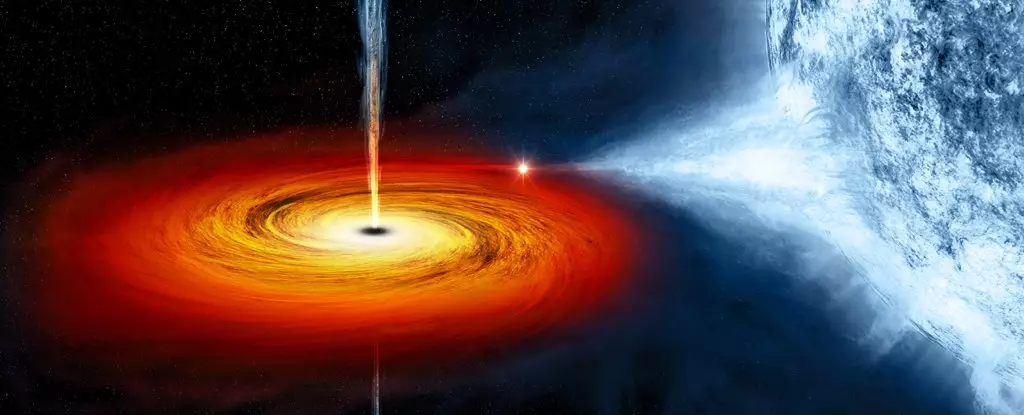For decades, the scientific community has believed that the universe’s highest-energy gamma rays predominantly originate from supermassive black holes (SMBHs) residing in distant galaxies, particularly within the vibrant activity of quasars. However, recent findings regarding V4641 Sagittarii, a microquasar just 20,000 light-years away in the constellation of Sagittarius, challenge longstanding assumptions and offer groundbreaking insights into the phenomena governing these mysterious particles.
V4641 Sagittarii contains a black hole approximately six times the mass of our Sun. This black hole is engaged in a voracious feasting on a companion star that weighs around three solar masses, turning the region into an energetic site that rivals other more massive cosmic entities. Researchers recently detected gamma rays from this microquasar reaching extraordinary energies of up to 200 teraelectronvolts (TeV). Such levels of energy, staggering by any measure, prompt a reassessment of our understanding of gamma-ray emissions.
Microquasars, which are essentially smaller analogs to regular quasars, have typically been characterized by significantly lower energy emissions. Historical data suggests that the gamma rays emitted from these microquasars usually range in the tens of gigaelectronvolts. However, the revelations from V4641 Sagittarii illustrate that these celestial bodies may churn out gamma radiation on an energy scale previously believed to be exclusive to their larger counterparts.
Sabrina Casanova, an astrophysicist at the Institute of Nuclear Physics Polish Academy of Sciences, indicated that the data has revealed phenomena that contradict conventional expectations. The high energy emissions observed here compel us to rethink not only microquasars but also the broader mechanics of cosmic radiation. As Casanova stated, “Photons detected from microquasars have usually much lower energies than those from quasars,” pointing to a divide that has perhaps been insufficiently understood until now.
The pivotal insights into V4641 Sagittarii’s gamma ray emissions were uncovered through the High-Altitude Water Cherenkov (HAWC) observatory, situated on the slopes of the now-dormant Sierra Negra volcano in Mexico. HAWC’s construction, which comprises 300 steel tanks filled with purified water, is fine-tuned for detecting high-energy particles. When these particles penetrate a tank, they inspire a cascade of subsequent particles traveling faster than the speed of light in water, leading to the production of Cherenkov radiation, often likened to a cosmic sonic boom.
This radiation is detected by sensitive sensors lining the tank interiors, allowing scientists to deduce the nature of the originating particle and its trajectory. HAWC boasts the capability to observe 15 percent of the sky at any moment, scanning two-thirds of the entire celestial sphere within 24 hours to create a comprehensive cosmic map.
It was during the examination of these maps that researcher Xiaojie Wang identified V4641 Sagittarii as a luminous source of gamma rays, emerging conspicuously from a previously unexamined region of space.
The identification and analysis of V4641 Sagittarii do more than simply expand our knowledge of microquasars; they open doors to further exploration into a variety of cosmic phenomena. Other microquasars, such as SS 433, have emitted gamma rays in excess of 25 TeV; however, V4641 Sagittarii’s emissions align closer to those produced by conventional quasars, defying pre-existing paradigms about the energy capacities of these entities.
Understanding how these processes unfold in microquasars, particularly the accelerated timeline compared to their larger counterparts, serves as a significant scientific advantage. While the environments surrounding SMBHs evolve over millions of years, microquasars like V4641 Sagittarii exhibit similar activity over mere days, allowing astronomers to study rapid processes that would otherwise take eons under different conditions.
The discovery of intense gamma ray emissions from V4641 Sagittarii not only alters the landscape of astrophysical research but also suggests new possibilities for studying cosmic phenomena. This intriguing microquasar serves as a natural laboratory, where accelerated cosmic processes can be scrutinized at a pace conducive to contemporary observational technology. The implications for understanding particle physics and the fundamental processes at play in black hole physics are vast and potentially transformative for astronomy.
V4641 Sagittarii is not just an object of interest; it is a reminder of how much more we have yet to discover in the vastness of space. The cosmos continually pushes the boundaries of our knowledge, revealing complexities that challenge our existing models and understanding. This profound moment in astrophysics demonstrates that proximity does not diminish the spectacle of cosmic phenomena; rather, it can amplify our grasp of the intricate relationship between black holes, the materials they consume, and the high-energy phenomena they produce.


Leave a Reply